12 § 1: The Nature of the Corporation










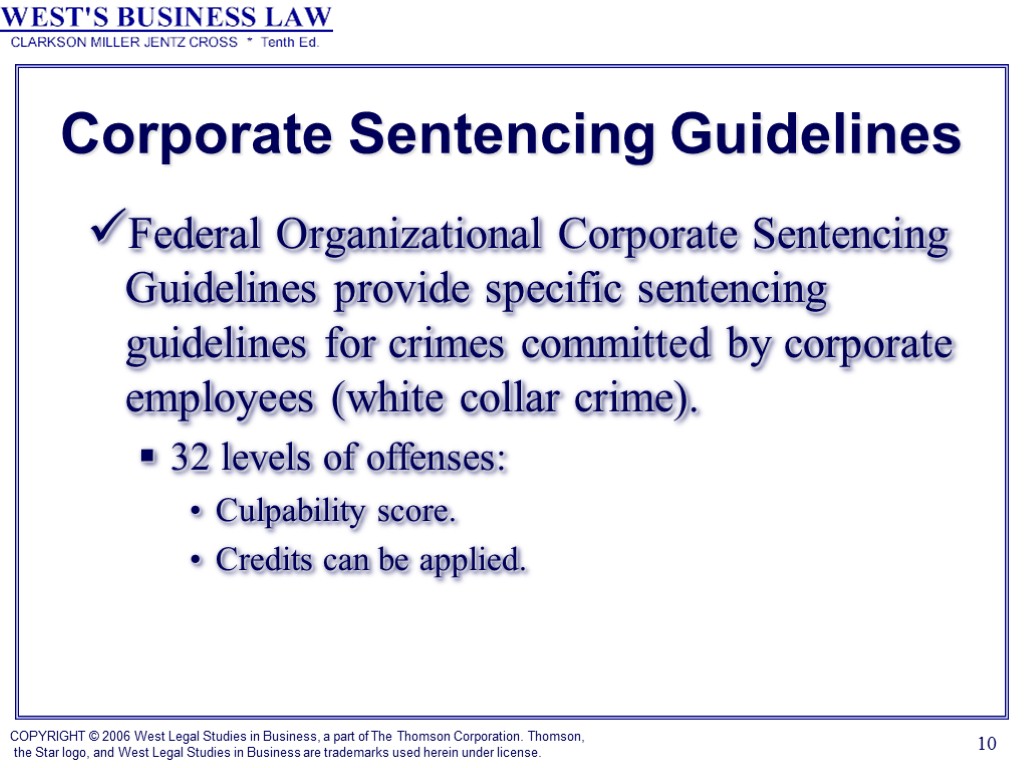

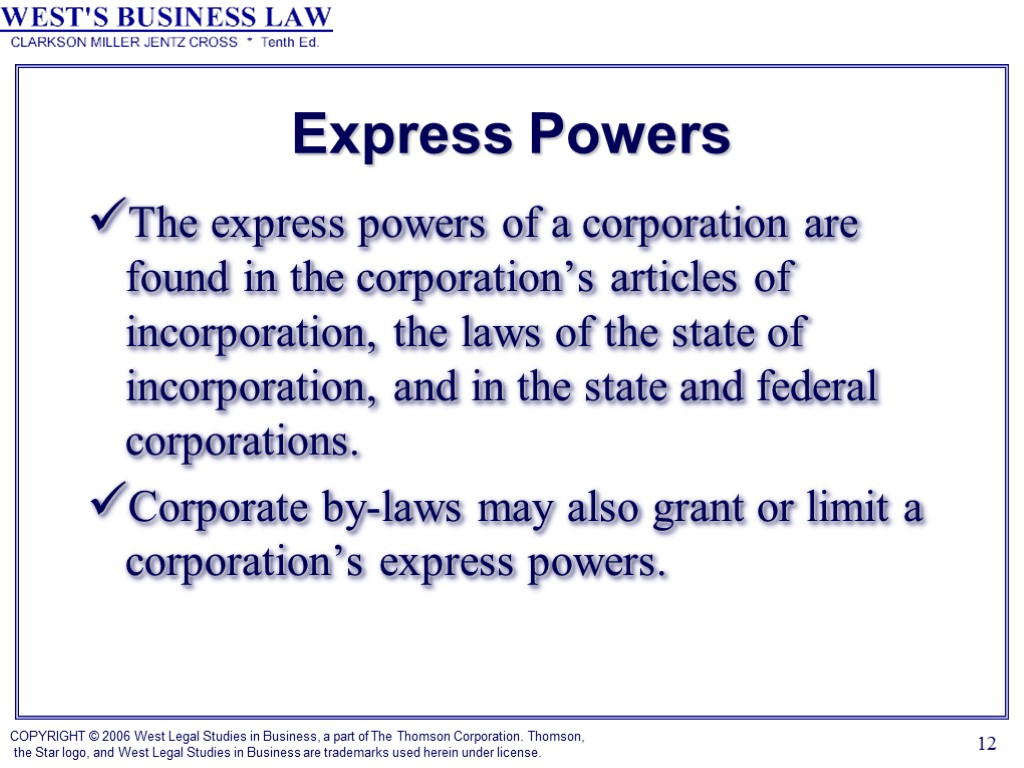



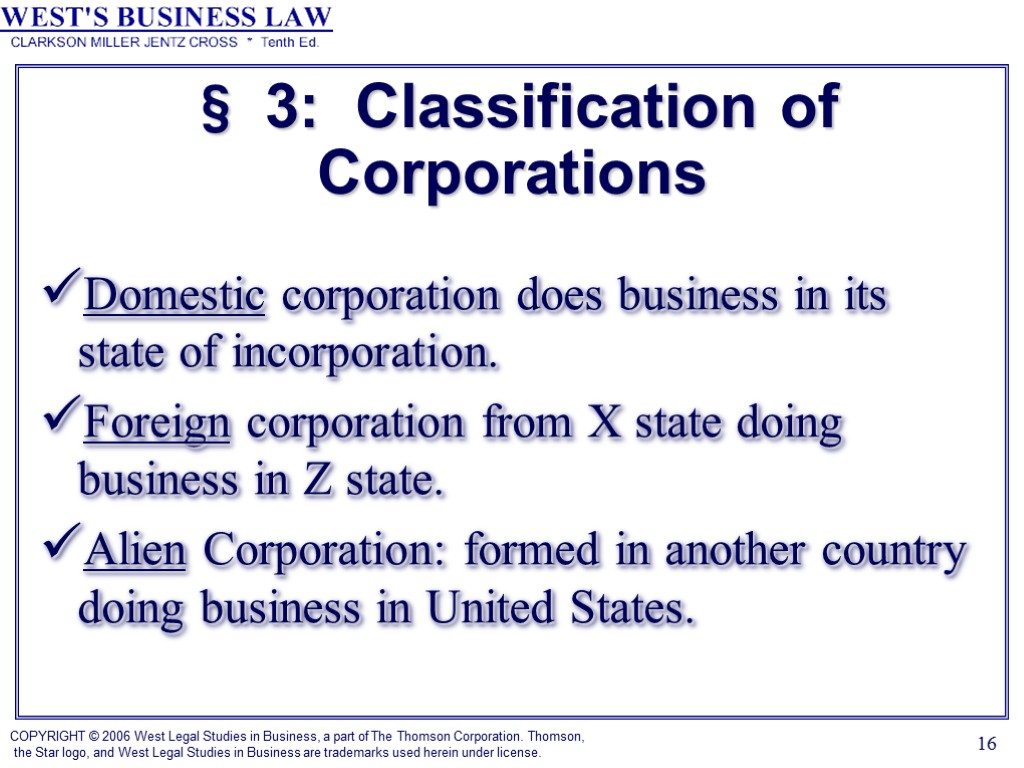

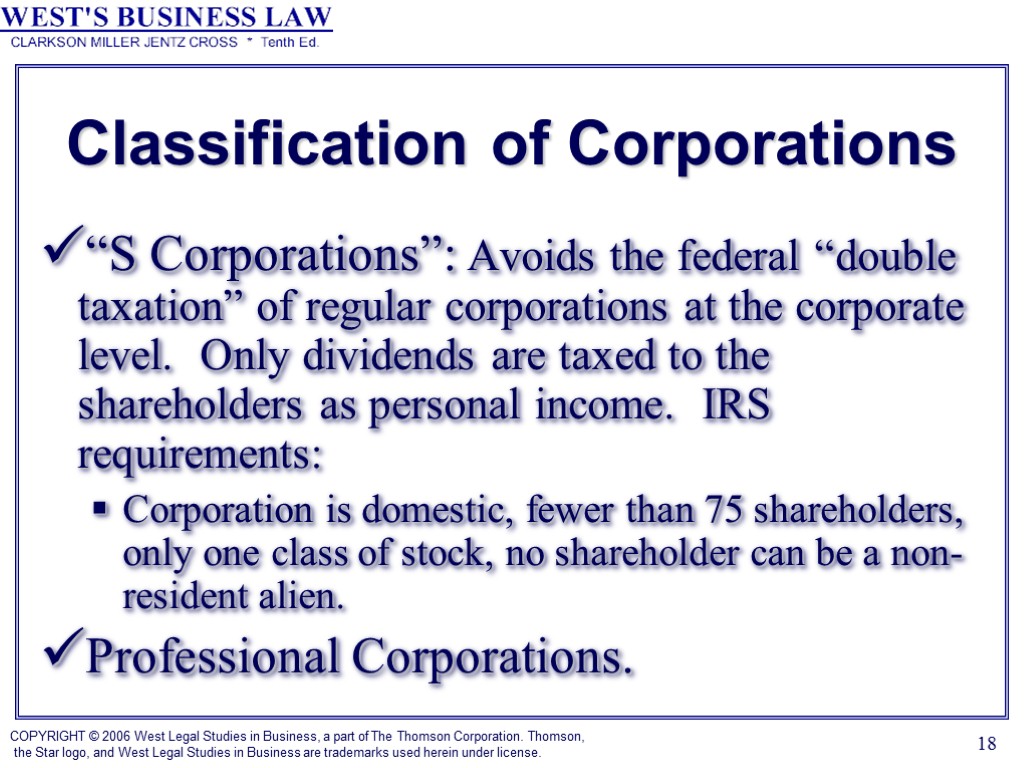




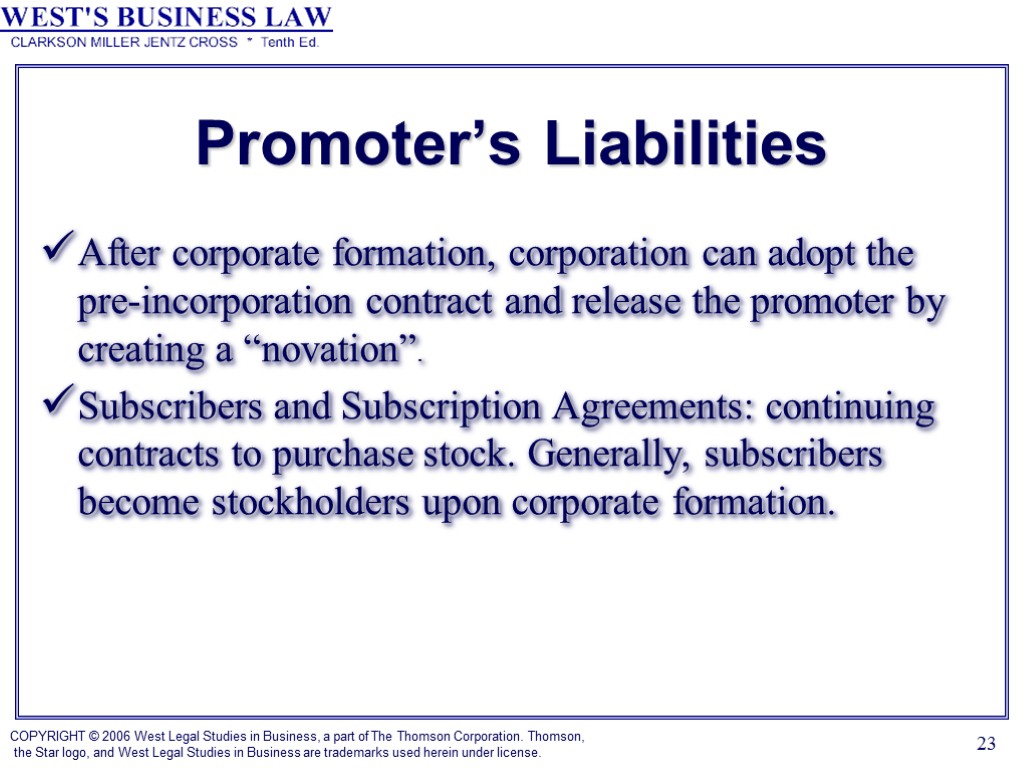













corporations-formation_and_financing.ppt
- Количество слайдов: 36
 1
1
 2 § 1: The Nature of the Corporation A corporation is a creature of statute, an artificial “person.” Most states follow the Model Business Corporation Act (MBCA) or the RMBCA, that are model corporation laws. The shares (stock) of a corporation are owned by at least one shareholder (stockholder).
2 § 1: The Nature of the Corporation A corporation is a creature of statute, an artificial “person.” Most states follow the Model Business Corporation Act (MBCA) or the RMBCA, that are model corporation laws. The shares (stock) of a corporation are owned by at least one shareholder (stockholder).
 3 Nature of the Corporation The corporation substitutes itself for the natural persons in conducting corporate business and incurring liability, but its authority and liability are separate and apart from the shareholders. In certain situations, the corporate “veil” of limited liability can be pierced, holding the shareholders personally liable.
3 Nature of the Corporation The corporation substitutes itself for the natural persons in conducting corporate business and incurring liability, but its authority and liability are separate and apart from the shareholders. In certain situations, the corporate “veil” of limited liability can be pierced, holding the shareholders personally liable.
 4 Corporate Personnel Individual shareholders own corporation. Shareholders elect board of directors to manage corporation. Board of directors hires officers to run corporation on a daily basis.
4 Corporate Personnel Individual shareholders own corporation. Shareholders elect board of directors to manage corporation. Board of directors hires officers to run corporation on a daily basis.
 5 Corporate Personnel Body of shareholders can change constantly without affecting the continued existence of the corporation. Shareholder can sue corporation and be sued by corporation and bring suit for corporation in some instances (derivative action).
5 Corporate Personnel Body of shareholders can change constantly without affecting the continued existence of the corporation. Shareholder can sue corporation and be sued by corporation and bring suit for corporation in some instances (derivative action).
 6 Corporate Taxation Corporate profits can either be kept as retained earnings or passed on to the shareholders as dividends. Corporate profits are taxed under federal and state law as a separate “person” from its shareholders. Regular “C” corporations are taxed twice: at the corporate level and at the shareholder level.
6 Corporate Taxation Corporate profits can either be kept as retained earnings or passed on to the shareholders as dividends. Corporate profits are taxed under federal and state law as a separate “person” from its shareholders. Regular “C” corporations are taxed twice: at the corporate level and at the shareholder level.
 7 Constitutional Rights of Corporations A corporation is an artificial “person” and has constitutional rights to: Equal protection; Access to the courts, can sue and be sued; Right to due process before denial of life, liability or property.
7 Constitutional Rights of Corporations A corporation is an artificial “person” and has constitutional rights to: Equal protection; Access to the courts, can sue and be sued; Right to due process before denial of life, liability or property.
 8 Constitutional Rights of Corporations Corporation’s rights (cont’d): Freedom from unreasonable search and seizure and double jeopardy. Freedom of speech. Only officers and directors have protection against self-incrimination. However, corporations do not have full protection of privileges and immunities clause.
8 Constitutional Rights of Corporations Corporation’s rights (cont’d): Freedom from unreasonable search and seizure and double jeopardy. Freedom of speech. Only officers and directors have protection against self-incrimination. However, corporations do not have full protection of privileges and immunities clause.
 9 Torts and Criminal Acts A corporation is liable for the torts committed by its agents or officers within the course and scope of their employment under the doctrine of respondeat superior. Corporation can be liable for criminal acts, but only fined. Responsible officers may go to prison.
9 Torts and Criminal Acts A corporation is liable for the torts committed by its agents or officers within the course and scope of their employment under the doctrine of respondeat superior. Corporation can be liable for criminal acts, but only fined. Responsible officers may go to prison.
 10 Corporate Sentencing Guidelines Federal Organizational Corporate Sentencing Guidelines provide specific sentencing guidelines for crimes committed by corporate employees (white collar crime). 32 levels of offenses: Culpability score. Credits can be applied.
10 Corporate Sentencing Guidelines Federal Organizational Corporate Sentencing Guidelines provide specific sentencing guidelines for crimes committed by corporate employees (white collar crime). 32 levels of offenses: Culpability score. Credits can be applied.
 11 § 2: Corporate Powers A corporation may act and enter into contracts as any natural person, except as limited by: U.S. Constitution. State constitutions. State statutes. Its own articles of incorporation. Its own corporate bylaws. Resolutions by its own board.
11 § 2: Corporate Powers A corporation may act and enter into contracts as any natural person, except as limited by: U.S. Constitution. State constitutions. State statutes. Its own articles of incorporation. Its own corporate bylaws. Resolutions by its own board.
 12 Express Powers The express powers of a corporation are found in the corporation’s articles of incorporation, the laws of the state of incorporation, and in the state and federal corporations. Corporate by-laws may also grant or limit a corporation’s express powers.
12 Express Powers The express powers of a corporation are found in the corporation’s articles of incorporation, the laws of the state of incorporation, and in the state and federal corporations. Corporate by-laws may also grant or limit a corporation’s express powers.
 13 Implied Corporate Powers Corporation has implied powers to: to perform all acts reasonably necessary to accomplish its corporate purposes, e.g.,: Borrow and lend money. Extend credit. Make charitable contributions. A corporate officer can bind corporation in contract in matters connected with the ordinary business affairs of the enterprise.
13 Implied Corporate Powers Corporation has implied powers to: to perform all acts reasonably necessary to accomplish its corporate purposes, e.g.,: Borrow and lend money. Extend credit. Make charitable contributions. A corporate officer can bind corporation in contract in matters connected with the ordinary business affairs of the enterprise.
 14 Ultra Vires Doctrine Corporate acts are beyond the express or implied powers of the corporation as stated in state statute or the corporation’s own articles of incorporations and are considered to be “ultra vires” (beyond the powers). Corporate articles of incorporations now adopt very broad purposes to prevent lawsuits against the corporation.
14 Ultra Vires Doctrine Corporate acts are beyond the express or implied powers of the corporation as stated in state statute or the corporation’s own articles of incorporations and are considered to be “ultra vires” (beyond the powers). Corporate articles of incorporations now adopt very broad purposes to prevent lawsuits against the corporation.
 15 Ultra Vires Doctrine The Following remedies are available for ultra vires acts: Shareholders can bring action for corporation. Corporation can recover damages from its officers and directors. Attorney general of state may bring action to dissolve corporation for ultra vires acts.
15 Ultra Vires Doctrine The Following remedies are available for ultra vires acts: Shareholders can bring action for corporation. Corporation can recover damages from its officers and directors. Attorney general of state may bring action to dissolve corporation for ultra vires acts.
 16 § 3: Classification of Corporations Domestic corporation does business in its state of incorporation. Foreign corporation from X state doing business in Z state. Alien Corporation: formed in another country doing business in United States.
16 § 3: Classification of Corporations Domestic corporation does business in its state of incorporation. Foreign corporation from X state doing business in Z state. Alien Corporation: formed in another country doing business in United States.
 17 Classification of Corporations Public and Private. Nonprofit. Close Corporations. Shares held by few shareholders. More informal management,similar to a partnership. Restriction on transfer of shares. Case 38.1: Salt Lake Tribune Publishing Co. v. AT&T Corp. (2003).
17 Classification of Corporations Public and Private. Nonprofit. Close Corporations. Shares held by few shareholders. More informal management,similar to a partnership. Restriction on transfer of shares. Case 38.1: Salt Lake Tribune Publishing Co. v. AT&T Corp. (2003).
 18 Classification of Corporations “S Corporations”: Avoids the federal “double taxation” of regular corporations at the corporate level. Only dividends are taxed to the shareholders as personal income. IRS requirements: Corporation is domestic, fewer than 75 shareholders, only one class of stock, no shareholder can be a non-resident alien. Professional Corporations.
18 Classification of Corporations “S Corporations”: Avoids the federal “double taxation” of regular corporations at the corporate level. Only dividends are taxed to the shareholders as personal income. IRS requirements: Corporation is domestic, fewer than 75 shareholders, only one class of stock, no shareholder can be a non-resident alien. Professional Corporations.
 19 § 4: Corporate Formation The process of incorporation generally involves two steps: Preliminary and Promotional Activities; and The Legal Process of Incorporation.
19 § 4: Corporate Formation The process of incorporation generally involves two steps: Preliminary and Promotional Activities; and The Legal Process of Incorporation.
 20 Incorporation Process Promotion Name Search File Articles of Incorporation Subscribers 1st Organiza-tional Meeting State Charter
20 Incorporation Process Promotion Name Search File Articles of Incorporation Subscribers 1st Organiza-tional Meeting State Charter
 21 Promotional Activities Before corporation is formed, promoters are the persons who take the preliminary steps of organizing the venture and attracting investors via subscription agreements.
21 Promotional Activities Before corporation is formed, promoters are the persons who take the preliminary steps of organizing the venture and attracting investors via subscription agreements.
 22 Promoter’s Liability A Promoter (or corporation) can create a prospectus required by federal and state securities laws to inform and protect investors. Promoter is personally liable for pre-incorporation contracts on behalf of the corporation, unless 3rd party agrees to hold future corporation liable.
22 Promoter’s Liability A Promoter (or corporation) can create a prospectus required by federal and state securities laws to inform and protect investors. Promoter is personally liable for pre-incorporation contracts on behalf of the corporation, unless 3rd party agrees to hold future corporation liable.
 23 Promoter’s Liabilities After corporate formation, corporation can adopt the pre-incorporation contract and release the promoter by creating a “novation”. Subscribers and Subscription Agreements: continuing contracts to purchase stock. Generally, subscribers become stockholders upon corporate formation.
23 Promoter’s Liabilities After corporate formation, corporation can adopt the pre-incorporation contract and release the promoter by creating a “novation”. Subscribers and Subscription Agreements: continuing contracts to purchase stock. Generally, subscribers become stockholders upon corporate formation.
 24 Incorporation Procedures State Chartering: Case 38.2: Bullington v. Palangio (2001). Select state (some states such as Delaware cater to corporations http://www.state.de.us/corp/ ). Articles of Incorporation: primary enabling document filed with the Secretary of State that includes basic information about the corporation. Person(s) who execute the articles are the incorporators. See sample articles of incorporation at the Texas Secretary of State. http://www.sos.state.tx.us/corp/forms.shtml
24 Incorporation Procedures State Chartering: Case 38.2: Bullington v. Palangio (2001). Select state (some states such as Delaware cater to corporations http://www.state.de.us/corp/ ). Articles of Incorporation: primary enabling document filed with the Secretary of State that includes basic information about the corporation. Person(s) who execute the articles are the incorporators. See sample articles of incorporation at the Texas Secretary of State. http://www.sos.state.tx.us/corp/forms.shtml
 25 Incorporation Procedures Choose and reserve a Corporate Name. Name must have the proper suffix: “Corporation,” “Corp.,” “Incorporated.” You should also consider registering the corporation as a “dot com” at networksolutions.com or register.com.
25 Incorporation Procedures Choose and reserve a Corporate Name. Name must have the proper suffix: “Corporation,” “Corp.,” “Incorporated.” You should also consider registering the corporation as a “dot com” at networksolutions.com or register.com.
 26 Incorporation Procedures Purpose: trend towards “any legal business.” Duration: usually perpetual. Capital Structure: Most states require some minimal capitalization (Texas requires $1,000), plus number and class(es) of shares authorized and “par value” of shares at incorporation.
26 Incorporation Procedures Purpose: trend towards “any legal business.” Duration: usually perpetual. Capital Structure: Most states require some minimal capitalization (Texas requires $1,000), plus number and class(es) of shares authorized and “par value” of shares at incorporation.
 27 Incorporation Procedures Internal Organization: usually included in the bylaws. Registered Office and Agent: specific person that will receive any legal notice and documents from state and/or 3rd parties. Incorporators (usually the promoter): at least one with name and address.
27 Incorporation Procedures Internal Organization: usually included in the bylaws. Registered Office and Agent: specific person that will receive any legal notice and documents from state and/or 3rd parties. Incorporators (usually the promoter): at least one with name and address.
 28 First Organizational Meeting After the corporation is “chartered” (created) it can do business. Shareholders should have the first organizational meeting to: approve the bylaws, elect directors, hire officers and adopt pre-incorporation contracts and activities.
28 First Organizational Meeting After the corporation is “chartered” (created) it can do business. Shareholders should have the first organizational meeting to: approve the bylaws, elect directors, hire officers and adopt pre-incorporation contracts and activities.
 29 § 5: Improper Incorporation Errors in incorporation procedures when a 3rd party seeks to bring an action against a corporation that may not have complied perfectly with every incorporation law. Problematic for shareholders who may be personally liable. In addition, entity may not be able to enforce contracts.
29 § 5: Improper Incorporation Errors in incorporation procedures when a 3rd party seeks to bring an action against a corporation that may not have complied perfectly with every incorporation law. Problematic for shareholders who may be personally liable. In addition, entity may not be able to enforce contracts.
 30 Improper Incorporation De Jure: substantial statutory requirements are met; cannot be attacked by state or 3rd parties. De Facto: statutory requirements not met, but promoters made good faith effort to comply with corporate law;corporate status can only be attacked by state. By Estoppel: if it acts like a corporation, cannot avoid liability by claiming that no corporation exists.
30 Improper Incorporation De Jure: substantial statutory requirements are met; cannot be attacked by state or 3rd parties. De Facto: statutory requirements not met, but promoters made good faith effort to comply with corporate law;corporate status can only be attacked by state. By Estoppel: if it acts like a corporation, cannot avoid liability by claiming that no corporation exists.
 31 § 6: Disregarding the Corporate Entity “Piercing the Corporate Veil” occurs when a court, in the interest of justice or fairness,” holds shareholders personally liable for corporate acts. Court concludes that shareholders used corporation as a “shield” from illegal activity.
31 § 6: Disregarding the Corporate Entity “Piercing the Corporate Veil” occurs when a court, in the interest of justice or fairness,” holds shareholders personally liable for corporate acts. Court concludes that shareholders used corporation as a “shield” from illegal activity.
 32 Piercing the Corporate Veil Factors a court considers: 3rd party tricked into dealing with a corporation rather than the individual. Corporation is set up never to make a profit or remain insolvent or is under capitalized. Statutory formalities are not followed.
32 Piercing the Corporate Veil Factors a court considers: 3rd party tricked into dealing with a corporation rather than the individual. Corporation is set up never to make a profit or remain insolvent or is under capitalized. Statutory formalities are not followed.
 33 Corporation is “alter ego” of majority shareholder and personal and corporate interest are commingled such that the corporation has no separate identity. Case 38.3: In re Flutie New York Corp. (2004). Piercing the Corporate Veil
33 Corporation is “alter ego” of majority shareholder and personal and corporate interest are commingled such that the corporation has no separate identity. Case 38.3: In re Flutie New York Corp. (2004). Piercing the Corporate Veil
 34 § 7: Corporate Financing Bonds v. Stocks Debt Ownership/equity Fixed ROI Dividends (variable) No votes Vote for Management Optional Required Priority over stock Paid last Stocks: Common vs. Preferred
34 § 7: Corporate Financing Bonds v. Stocks Debt Ownership/equity Fixed ROI Dividends (variable) No votes Vote for Management Optional Required Priority over stock Paid last Stocks: Common vs. Preferred
 35 Bonds
35 Bonds
 36 Stocks Common Stock: represents true ownership of a corporation. Provides pro-rata (proportional) ownership interest reflected in control, earnings and assets. Preferred Stock: has preferences over common stock. Cumulative Preferred. Participating Preferred. Convertible Preferred. Redeemable or Callable Preferred.
36 Stocks Common Stock: represents true ownership of a corporation. Provides pro-rata (proportional) ownership interest reflected in control, earnings and assets. Preferred Stock: has preferences over common stock. Cumulative Preferred. Participating Preferred. Convertible Preferred. Redeemable or Callable Preferred.

